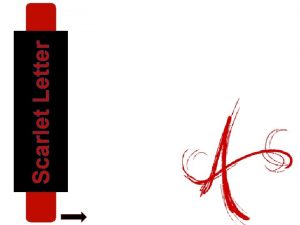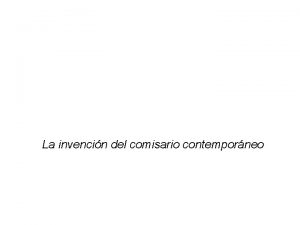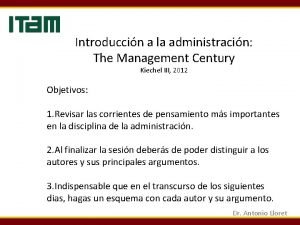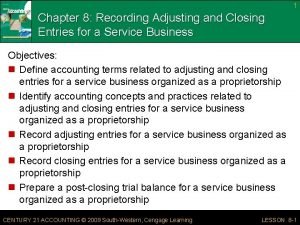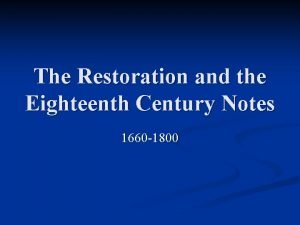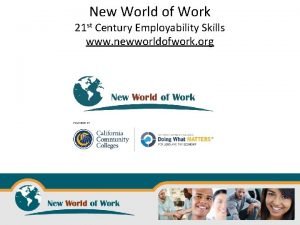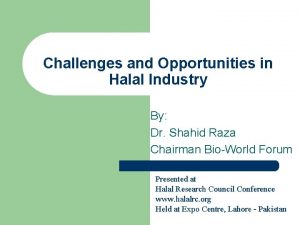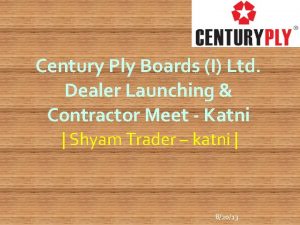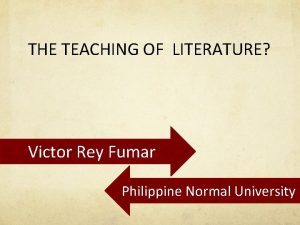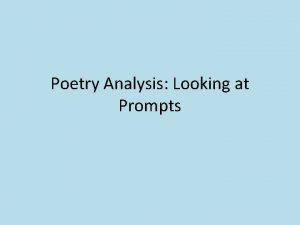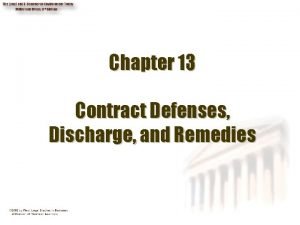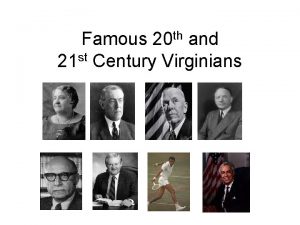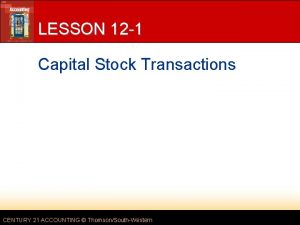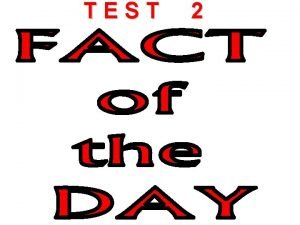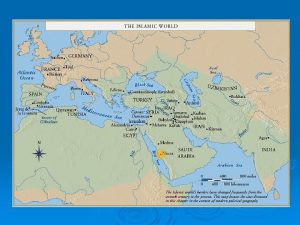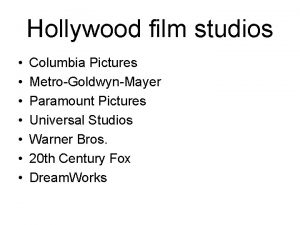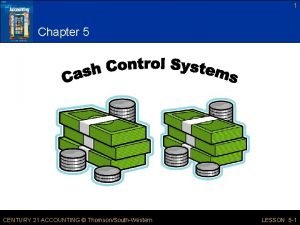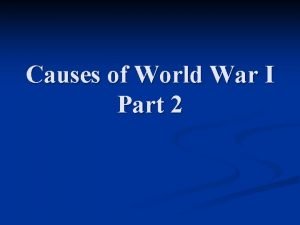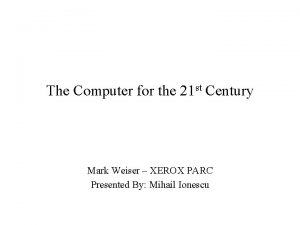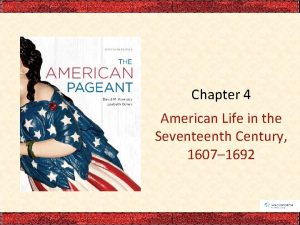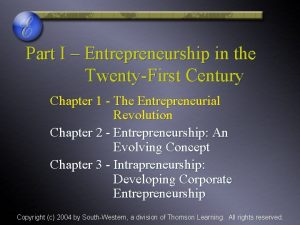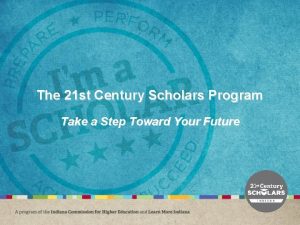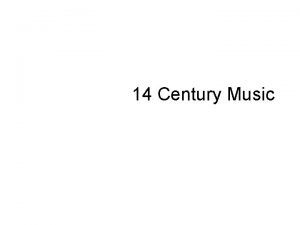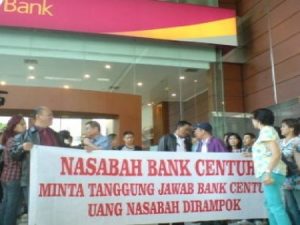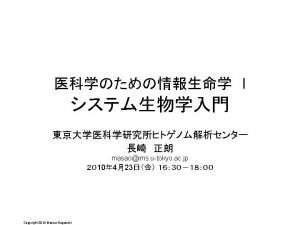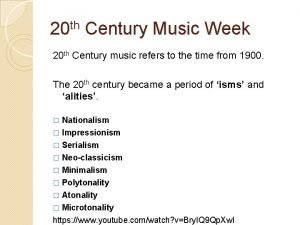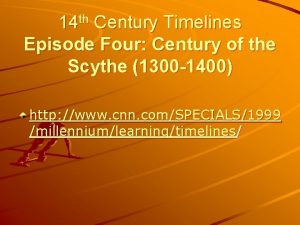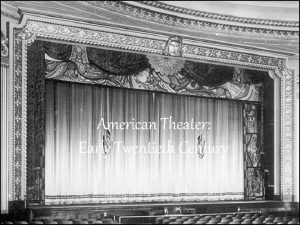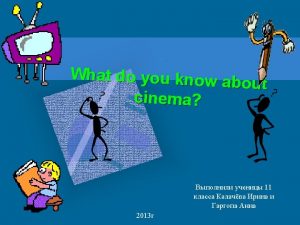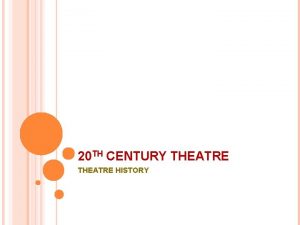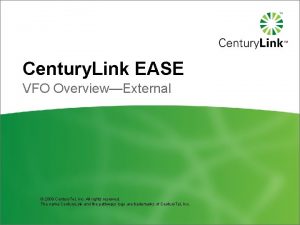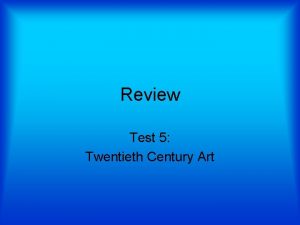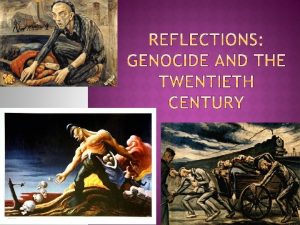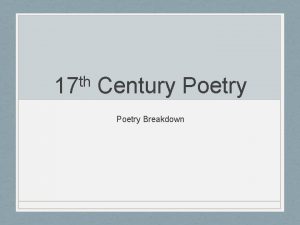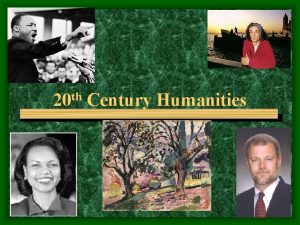21 st Century Education 20 th Century Education












![AUN-QA Criterion 1 Expected Learning Outcomes [1] The curriculum is developed to promote learning, AUN-QA Criterion 1 Expected Learning Outcomes [1] The curriculum is developed to promote learning,](https://slidetodoc.com/presentation_image_h/bd49cb009c0926f4e188227cbd24977d/image-13.jpg)

















- Slides: 30



21 st Century Education 20 th Century Education. Time-based 21 st Century Education. Outcome-based Learning is designed on upper levels Lessons focus on the lower level of of Blooms’ – synthesis, analysis and evaluation (and include lower levels Bloom’s Taxonomy – knowledge, comprehension and application. as curriculum is designed down from the top. ) Textbook-driven Research-driven Passive learning Active Learning Learners work collaboratively with Learners work in isolation – classmates and others around the classroom within 4 walls world – the Global Classroom Teacher-centered: teacher is center Student-centered: teacher is of attention and provider of facilitator/coach information Little to no student freedom Great deal of student freedom 3 Source: http: //www. 21 stcenturyschools. com/what_is_21 st_century_education. htm Integrated and Interdisciplinary Fragmented curriculum Education in the 21 st Century

What is Quality Assurance (QA)? Quality assurance can be described as the systematic, structured and continuous attention to quality in terms of maintaining and improving quality. Source: AUN-QA Manual for the Implementation of the Guidelines, P 20 Quality assurance in higher education can be defined as systematic management and assessment procedures to monitor performance of higher education institutions. Source: The Regional Report of Asia and the Pacific (UNESCO, 2003 b) 4 QA in Higher Education

Bangkok Accord 2000 2004 Establishment 2006 2007 Initiation 2011 Implementation Improvement 5 http: //www. aunsec. org/publications. php

AUN-QA Model for Higher Education Quality Assurance at Programme Level Stakeholders Satisfaction How ELO’s are translated into the programme and can be achieved via teaching and learning strategy and student assessment Expected Learning Outcomes Input of the process: academic and support staff, student quality, student advice and support, and facilities and infrastructure Quality assurance process of teaching and learning, staff development and stakeholders feedback Outcomes of the learning process: pass rates, dropout rates, average time to graduate, employability of the graduates, and research activities Quality Assurance and (Inter)national Benchmarking A c h i e v e m e n t s 6

AUN-QA Model for Higher Education Quality Assurance at Programme Level # ����� 15 AUN-QA Stakeholders Satisfaction 2 3 Programme Specification 6 1 Expected Learning Outcomes Programme Structure & Content 5 Teaching & Learning Strategy Student Assessment 8 7 Academic Staff Quality 4 Support Staff Quality 11 9 Student Quality Facilities & Infrastructure 13 12 Quality Assurance of Teaching & Learning 10 Student Advice & Support Staff Development Activities Stakeholder Feedback 14 Pass Rates Drop Out Rates Graduation Time Employability Research Quality Assurance and (Inter)national Benchmarking A c h i e v e m e n t s 7

Business Process Marketing Research Design • Materials, Man, Machine, Method Production • Product spec. • Design Process Sal e • Product • Monitor, Control and Improvement (QC and QI to get QA)

AUN-QA Marketing Research • • Program Spec (2) Design (Man) Academic staff quality (6) Support staff quality (7) Staff development activities (12) (Machine) Facilities and Infrastructure (10) Production Sale • Design Product spec. (ELO) (1) • Design Process • Design Program Structure and Content (3) • (Material) Admission (Student quality (8)) • (Method) Student Advice and support • (Method) Teaching and Learning (9) strategy (4) • (Method) student assessment (5) • Output (14) • Outcome (Stakeholder satisfaction (15)) • Monitor, Control and Improvement (Quality Assurance of Teaching and Learning Process) (11) and Stakeholders feedback (13))

7 -point rating scale for quality assessment Meaning of the Value Looking at the Quality and Improvement Activities 1 = nothing (no documents, no plans, no evidence) present 1 = absolutely inadequate; immediate improvements must be made 2 = this subject is in the planning stage 2 = inadequate, improvements necessary 3 = documents available, but no clear evidence that they are used 3 = inadequate, but minor improvements will make it adequate 4 = documents available and evidence that 4 = adequate as expected (meeting AUNthey are used QA guidelines and criteria) 5 = clear evidence on the efficiency of the aspect 5 = better than adequate (exceeding AUNQA guidelines and criteria) 6 = example of best practices 7 = excellent (world-class or leading practices) 10

1 Criteria, 2 Description, 3 Checklist, 4 Explanation, 5 Diagnostic question, 6 Sources of Evidence 1 5 2 TRANSLATED TO SUB-CRITERION IN THE CHECKLIST ` 3 LIST IN THE AUN GUIDELINES 6 4 11

������������ CUPT QA ������� 2557 , 2 DESCRIPTION, 3 CHECKLIST, 4 EXPLANATION, 1 CRITERIA 5 DIAGNOSTIC QUESTION, 6 SOURCES OF EVIDENCE 1 2 3 4 5 6 12
![AUNQA Criterion 1 Expected Learning Outcomes 1 The curriculum is developed to promote learning AUN-QA Criterion 1 Expected Learning Outcomes [1] The curriculum is developed to promote learning,](https://slidetodoc.com/presentation_image_h/bd49cb009c0926f4e188227cbd24977d/image-13.jpg)
AUN-QA Criterion 1 Expected Learning Outcomes [1] The curriculum is developed to promote learning, learning how to learn and to instill in students a commitment of lifelong learning (e. g. commitment to critical inquiry, development of study and information-processing skills, a willingness to experiment with new ideas and practices). [2] The curriculum offers to graduates the ability to do advanced studies, to develop their own personality, to have an academic attitude and to be competent in their field of study. The graduates should also have transferable skills, leadership skills, and should be oriented to the job market and be able to develop their careers. [3] The curriculum has clearly formulated learning outcomes, 13 reflecting the relevant demands and needs of all stakeholders. CUPT QA หนา 31

Expected Learning Outcome (AUN 1) • The curriculum promote life-long learning (learn how to learn) • The curriculum develop ability to do advanced study, also transferable skills, leadership skills, relevant to job market • ELO reflect demands and needs of all stakeholders

AUN-QA Criterion 1 Expected Learning Outcomes Diagnostic questions • • • Why are we educating? What is the educational philosophy behind the programme? What are the expected learning outcomes? How are the programme learning outcomes formulated? Do the learning outcomes reflect the department’s goals? Does the labour market set any specific requirements for graduates to meet? • To what extent and how do we try to tune the programme to the labour market? • • • Is there a well-defined job profile? How are the learning outcomes made known to staff and students? To what extent do we think that the learning outcomes have been achieved? Do we review the learning outcomes? 15 How are the learning outcomes translated into the concrete requirements of the graduate (i. e. knowledge, skills and attitudes; and professional ethics)?

Program Structure and Content (AUN 3) • Curriculum meet the needs of stakeholders (includes vision and mission of the institution) • Curriculum shows balance between specialized content and generic knowledge and skill • Curriculum map to relate curriculum graduate competence and expected outcome of each course • Curriculum shows basic course, intermediate course and specialize course

Program Specification (AUN 2) • University publishes program spec. • Program spec. • Intended outcome: knowledge, key skills, cognitive skills, subject specific skill • Teaching and learning method • Assessment method • Program specification must be explicit, concise and understandable

Teaching and Learning Strategy (AUN 4) • Quality learning • Facilitate learning • Student-dependent approach • Relax, supportive, collaborative and informal learning environment • Promoting individual responsibility for learning • Action learning • Facilitate learning to learn

Student Quality (AUN 8) • Intake policy • Admission process • Study load • Correspond with prescribed load • Equally divided over and within academic year • Measure when actual load deviates from prescribed load

Student Assessment (AUN 5) • Assessment cover: Student Entrance, Progress and Exit Exam • • Variety of assessment method Criteria reference method Combination of peer-, self- and teacher assessment Standard, scope and weight of assessment are clear and accessible • Standards applied in assessment are explicit and clear • Assessment response diagnostic, formative and summative purpose • Reliability and validity of assessment

Student Advices and Support (AUN 9) • Student progress • Systematic monitored • Feedback and corrective action • Supportive learning environment • Physical, Social and psychological environment

Academic Staff Quality (AUN 6) • Competent and sufficient • Recruit • Role and responsibility • Duty allocation • Provision for review, consultation and redeployment • Appraisal • Promotion • Termination, retirement and benefit

Supporting Staff Quality (AUN 7) • Competent and sufficient • Library staffs • Computer staffs • Laboratory staffs • Administrative staffs

Staff Development Activities (AUN 12) • Staff training and development needs • Systematically identified • Related to individual aspiration, curriculum and institution requirement • Staff development plan • Implementation • Effectiveness of deployment

Facilities and Infrastructure (AUN 10) • Keywords: adequate and up-to-date • Lecture facilities • Library • Laboratory • Computer facilities • Environmental health and safety

Output (AUN 14) • Regards of student achievement and needs of stakeholder • • Pass rate Average time to study Employability Research activities

Stakeholders Feedback (AUN 13) • Adequate structure feedback from all stakeholders • • Labour market Student Alumni Staff

Stakeholder Satisfaction (AUN 15) • How is data involving stakeholder satisfactory acquired? • Use of satisfactory data to improve the program

Quality Assurance of Teaching and Learning Process (AUN 11) • • Curriculum design Course and curriculum evaluation Evaluation by student Continuous improvement • Results from evaluation • Stakeholder feedback

7 -point rating scale for quality assessment Meaning of the Value Looking at the Quality and Improvement Activities 1 = nothing (no documents, no plans, no evidence) present 1 = absolutely inadequate; immediate improvements must be made 2 = this subject is in the planning stage 2 = inadequate, improvements necessary 3 = documents available, but no clear evidence that they are used 3 = inadequate, but minor improvements will make it adequate 4 = documents available and evidence that they are used 4 = adequate as expected (meeting AUNQA guidelines and criteria) 5 = clear evidence on the efficiency of the aspect 5 = better than adequate (exceeding AUNQA guidelines and criteria) 6 = example of best practices 7 = excellent (world-class or leading practices) 30
 How does mistress hibbins eventually die?
How does mistress hibbins eventually die? Words allan kaprow
Words allan kaprow The management century
The management century 8-4 mastery problem post closing trial balance
8-4 mastery problem post closing trial balance Century model
Century model The restoration and the 18th century notes
The restoration and the 18th century notes Century 21 southwestern accounting
Century 21 southwestern accounting Half a century from 1964
Half a century from 1964 What is today
What is today New world of work 21st century skills
New world of work 21st century skills 21st century halal certificate
21st century halal certificate Century marine ply
Century marine ply Tanaga example
Tanaga example Robert pack an echo sonnet
Robert pack an echo sonnet Parker v twentieth century fox
Parker v twentieth century fox Famous virginians 21st century
Famous virginians 21st century Century 21 stock
Century 21 stock Horace taylor, the verdict, september 25, 1899
Horace taylor, the verdict, september 25, 1899 570 c.e means
570 c.e means Colombia paramount
Colombia paramount 5-1 work together p.128 answers
5-1 work together p.128 answers British empire 20th century
British empire 20th century Mark weiser the computer for the 21st century
Mark weiser the computer for the 21st century Chapter 4 american life in the seventeenth century
Chapter 4 american life in the seventeenth century Unit 6 early 20th century ga
Unit 6 early 20th century ga Helvetica gothic
Helvetica gothic Muhammad ali sportsman of the century
Muhammad ali sportsman of the century Lafayette cartoon marie antoinette
Lafayette cartoon marie antoinette Century 21 gemini realty
Century 21 gemini realty Twenty first century trends in entrepreneurship
Twenty first century trends in entrepreneurship Scholar track.in.gov
Scholar track.in.gov
